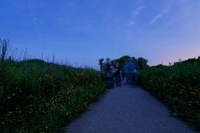Studies from urban environments around the world document the wide-ranging and substantial effects of fireworks. From auditory and visual trauma for humans and other animals to air quality and other environmental pollution, numerous studies make clear the negative effects of fireworks.
Among the throng of threats to our urban wildlife populations, however, fireworks seem relatively low on the list. The loud explosions and bright lights might be frightening, but perhaps no more so than an average day in the city filled with traffic, construction, airplanes, and other loud noises.
On the surface, fireworks seem comparable to thunderstorms. Both offer powerful displays of light and noise, so shouldn’t we (humans and other animals alike) be accustomed to that sort of thing? Thunderstorms are natural, true, (if also increasing due to climate change) but fireworks differ from thunderstorms notably in what they leave behind: plastic debris and harmful metal compounds that make their way into our land, water, and air.
As is often the case, the environmental impact of our activities can be hard to see, quantify, or directly attribute to a specific cause. Pollution from fireworks is mostly at the particle level, invisible or indiscernible to most humans without scientific tools. But the effects are real, nonetheless.
We have enough evidence about the impact of fireworks, both anecdotal and academic, to consider a different way to celebrate. For ecologists and the rest of us concerned about our living environments, it is certainly worth considering alternatives to fireworks. Are there better ways to celebrate?
Many cities and countries around the world have wrestled with this question and changed, restricted, or even banned fireworks celebrations in recent years. Some of these changes include using “quiet” fireworks, shifting to laser or drone shows, and creating stricter regulations on fireworks. Some firework companies are experimenting with more “eco-friendly” components, like paper or bamboo instead of plastic and nitrogen instead of carbon. But, as one German firework manufacturer admitted, “there is no such thing as a climate-neutral firework.” Indeed, many of these alternative “solutions” are simply ways to continue the status quo method of celebration with a slightly reduced impact.
I’ve got an alternative to offer, though, one that will surely elicit wonderment, and without any of the harmful effects of fireworks.
Over the July 4th weekend, I walked down the Milwaukee River and up to the arboretum at Riverside Park. Perched on top of the hill, dusk crept over the river valley, and I waited. One by one, fireflies began to dance low in the sky. Soon, they covered the hillside. I sat there for hours watching, mesmerized by their showy courtship ritual.

Last year I attended Urban Ecology Center and Milwaukee Public Museum firefly survey. We learned about the species found in Wisconsin, which of them perform bioluminescence, and how to distinguish between different species. Where once I had only seen a single creature, I learned there were dozens of species with glow patterns distinct in number, duration, frequency, and color.
It’s easy to appreciate fireflies. And that appreciation only grows when you learn about the story of their light. It’s a tale of love and longing, filled with nefarious characters, evolutionary adaptations, synchronicity, and even pandemic fighting. When we pay attention to the fireflies, there’s a lot we can learn. More scientists are now paying attention to fireflies, and they’re noticing many species in decline, which is all the more reason for us to take note of them.
Perhaps we can take a cue from the fireflies, and learn how to shine our lights. We aren’t capable of bioluminescence, but we too can harness the energy of the sun (if indirectly) to create beauty, celebrate life, and shine a light on the path towards a different relationship with the natural world. Maybe next summer, when your friends ask where you’re going to watch the fireworks, you’ll suggest a different kind of light show.
For optimal firefly viewing, find a nearby wild place in the city, ideally near wetlands and away from bright city lights. Head out around dusk, especially on a warm summer eve. Whether at Riverside Park or elsewhere in the city, let us know if you do some firefly exploring on your own. We’d love to hear about it!
By Ben Binversie, former UEC Communications and Research intern





